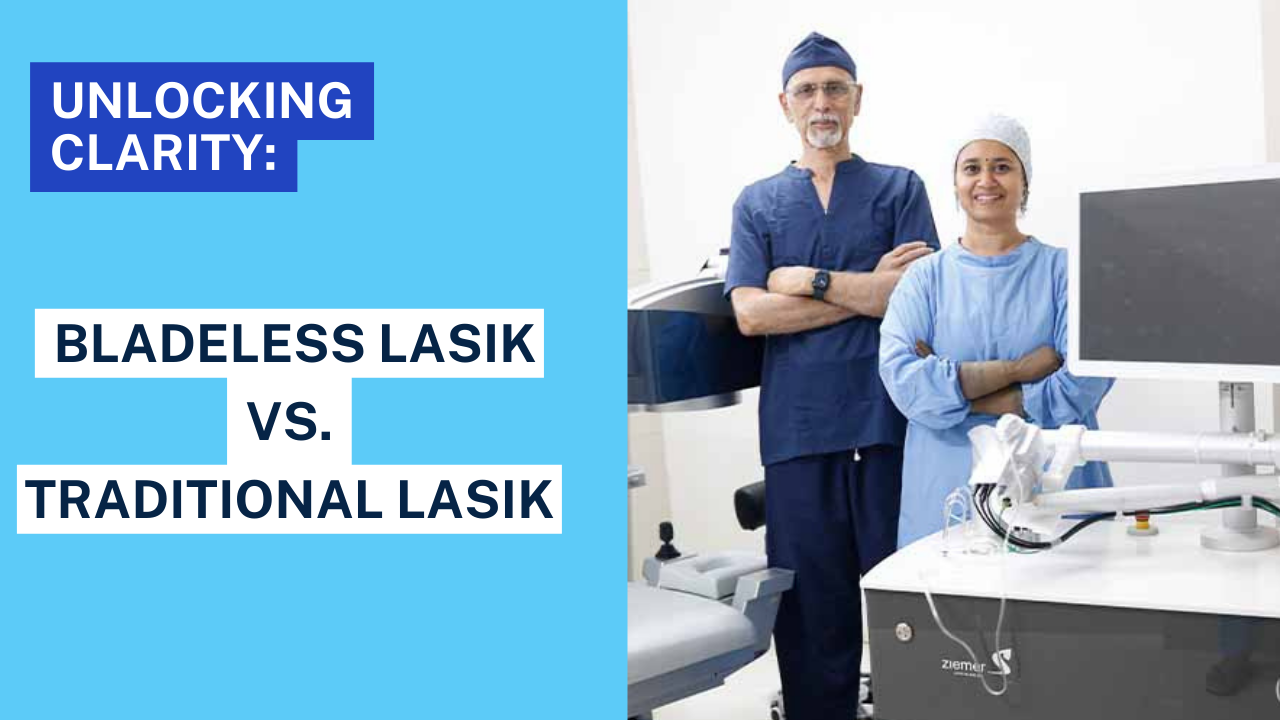Bladeless LASIK, or Femto-LASIK, is a sophisticated vision correction technique that has replaced the traditional blade-based LASIK surgery. Now, we will discuss the science behind Bladeless LASIK, how it works, and the benefits it offers to individuals seeking a clearer vision in India.
Understanding Traditional LASIK
Before we explore Bladeless LASIK, it’s essential to know the basics of traditional LASIK surgery. LASIK, short for Laser-Assisted In Situ Keratomileusis, corrects refractive vision errors such as myopia (nearsightedness), hyperopia (farsightedness), and astigmatism through a surgical procedure.
In traditional LASIK, a microkeratome, a mechanical device with a blade, creates a thin flap on the cornea. The surgeon lifts this flap and uses a laser to reshape the underlying and exposed corneal tissue, thereby correcting the refractive error. Once the surgeon reshapes the cornea, they reposition the flap, and the healing process begins.
While traditional LASIK has effectively provided clearer vision to millions of people worldwide, it comes with certain limitations and potential complications. The use of a microkeratome blade poses some risks, such as irregular flap creation and uneven corneal thickness, which can impact the final visual outcome.

The Science Behind Bladeless LASIK
Bladeless LASIK, on the other hand, eliminates the need for a microkeratome blade and relies on a highly precise femtosecond laser for the creation of the corneal flap. Here’s how the science behind Bladeless LASIK works:
Step 1: Cornea Mapping for Bladeless LASIK
The initial step of a Bladeless LASIK is mapping of the cornea. The cornea is mapped to understand its curvature, which helps the surgeon to understand the nature of the vision problem.
Step 2: Tailored Treatment
Once the nature of the vision problem is understood, the surgeon will tailor a suitable treatment for the patient’s situation.
Step 3: Corneal Flap Creation
Now, this is the step where the surgery starts. The process begins with the femtosecond laser creating a thin, hinged corneal flap. This laser emits short pulses of light, allowing for incredibly precise and controlled tissue removal. The laser creates a flap with a uniform thickness, size, and shape, reducing the risk of complications associated with irregular flaps.
Step 4: Corneal Reshaping
Once the flap is created, it is gently lifted, exposing the underlying corneal tissue. A different type of laser, known as an excimer laser, is used to reshape the cornea. This laser precisely removes microscopic amounts of corneal tissue to correct the specific refractive error of the patient. The level of precision offered by the excimer laser ensures that the corneal shape is altered to achieve the desired vision correction.
Step 5: Flap Replacement
The corneal flap is carefully repositioned after the laser has reshaped the cornea. The cornea’s natural adhesive properties enable the flap to adhere without the need for sutures. Over time, the flap naturally heals and integrates with the surrounding tissue.
Step 6: Patient Screening
The patient kept in screening after the surgery if they need immediate attention or care.
Benefits of Bladeless LASIK in India
Bladeless LASIK in India offers a revolutionary approach to vision correction with a range of advantages:
- Precision Treatment: Utilizes femtosecond laser technology for precise corneal flaps, enhancing overall outcome and reducing complications.
- Customized Options: The treatment is tailored based on individual corneal maps and 3D imaging. Ensuring a personalized approach for optimal results.
- Cost-Effective Solution: Despite advanced technology, bladeless LASIK proves cost-effective in the long run, making it a wise investment in visual freedom.
- Minimal Downtime: Swift recovery with minimal downtime, allowing patients to resume normal activities shortly after the procedure.
- Safety Measures: Rigorous preoperative evaluations and eligibility criteria ensure patients’ safety and contribute to overall success and satisfaction.
- Popularity and Growth: India witnesses a surge in demand for bladeless LASIK. It driven by increased awareness of its benefits and advancements in medical technology.
Conclusion
Bladeless LASIK has emerged as a groundbreaking vision correction procedure, offering individuals in India and worldwide a safer, more precise, and highly effective solution for refractive vision errors. The science behind Bladeless LASIK involves femtosecond and excimer lasers. This technology has revolutionized the field of ophthalmology. It provides patients with improved visual outcomes. It also offers faster recovery times.
As technology advances, Bladeless LASIK is expected to evolve. Further enhancing its benefits and accessibility for those looking for a life without the limitations of glasses or contact lenses. If you’re considering vision correction in India, exploring Bladeless LASIK as an option could be your first step toward a clearer and brighter future.
So, get ready for better eyesight with Bladeless LASIK at Laxmi Eye Institute and Hospital in Navi Mumbai with centers in Panvel, Kharghar, Kamothe, and Dombivali. Our expert doctors and modern facilities make it a safe choice. No more glasses or contacts – our treatment is precise, personalized, and secure. Recover quickly and enjoy a clear vision for a long time. Many people trust us, and you can too. Contact Laxmi Eye Institute and Hospital to start your journey to better vision. For questions and appointments, click here. Your eyes deserve the best – choose us for Bladeless LASIK.




